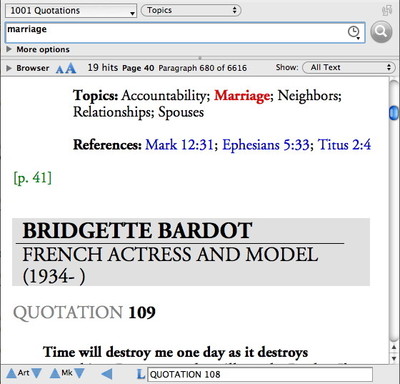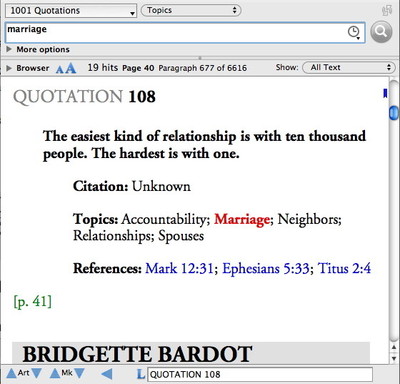Accordance modules are far more than mere electronic editions of print books. When we develop an Accordance module, we make a series of subtle design decisions aimed at making those resources as functional and easy-to-use as possible. Today, I’m going to pull back the curtain a bit and talk about one of the subtle design choices that went into the new Zondervan collections of Quotations and Illustrations I blogged about on Wednesday. I think it illustrates the care and craftmanship characteristic of Accordance module development.
As Accordance modules go, these were relatively simple to produce: no Greek or Hebrew to account for, no complicated tables, just straightforward English text. Because each quotation and illustration followed a consistent format, it was easy to distinguish fields like the title, the content, the topic, the author, and the source. Yet because each of these items was on a separate line, we noticed a usability issue in our initial testing, and we dusted off a seldom used option to overcome it.
When you search an Accordance tool, most tools will take you to the paragraph which contains the hit. After all, if you search the English Content of Anchor Bible Dictionary for a word, that word might appear in the middle of the tenth long paragraph of an article. To see the hit in context right away, you want to be taken right to the paragraph that contains it.
In these illustration and quotation databases, however, that default behavior results in an unfortunate workflow. For example, let’s say you search the Topics field of 1001 Quotations for “marriage.” The default behavior would result in your first hit looking like this:
Notice how the topic has been found, but since the topics are listed after the actual quotation, you would have to scroll up to see whether the quote found is what you were looking for. To scan through all the hits you would therefore have to scroll up to see the preceding quote, hit the down Mark button to go to the next hit in the Topics field, scroll up to see the quote, lather, rinse, and repeat for all 19 hits!
When searching these modules, you’re trying to find the perfect quotation or illustration regardless of whether you’re searching by keyword, author, topic, or whatever. So it’s important to be able to see the entire quote or illustration right away. For that reason, we designed these modules to display the article which contains a hit rather than the individual paragraph within that article. So when you search 1001 Quotations for the topic of “marriage,” you get this:
It may seem like a little thing, but this relatively simple design decision makes a world of difference in your workflow using these modules. Now when you do a search, you can quickly jump to each hit and immediately evaluate the corresponding quote or illustration.
When developing Accordance modules, we take the time to consider how you’re most likely to use those resources, and we make the design decisions which best facilitate that usage. Some of those decisions are so subtle you’re unlikely even to notice them. But then, that’s the point of good design, isn’t it?



